All about dishwashers
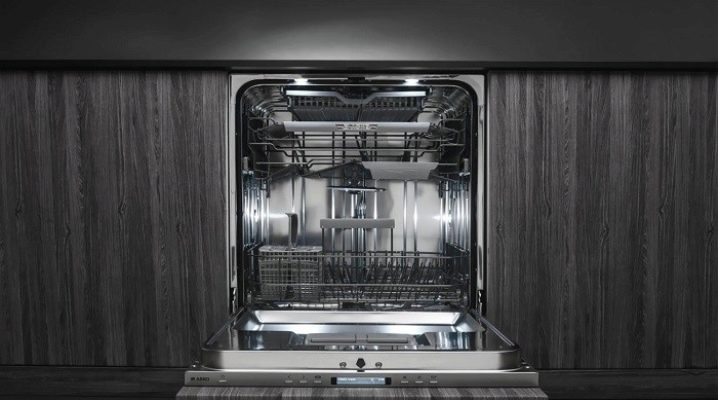
Currently, you can not see a dishwasher in every kitchen, so one might get the impression that such equipment is expensive and exotic. It is rather difficult to understand what this opinion of the citizens of Russia is connected with - either this is due to the lack of space in the kitchen, or because of the habit of doing all the routine work with our own hands. In fact, you can choose the right machine for almost any kitchen, the main thing is to know what criteria to look for. In addition, the dishwasher protects the skin of your hands, saves time and significantly reduces water consumption. In this article, we will consider the features, varieties and functionality of dishwashers, and also give some useful tips for choosing such a technique.

Features and purpose
The first dishwasher was invented back in 1850, but at that time the product was inconvenient and unreliable, so it did not gain widespread demand. After that, there were several more attempts to introduce such a useful technique, but all of them also failed. A truly usable machine that facilitates household chores was created by Englishman William Howard Leavens in 1924. It was similar to the modern one, but still needed improvement. The final design was made in 1940, but the product was still too expensive for the general public to use.

Dishwashers became popular only in the late 1970s, and by 2012 the device was installed in 75% of apartments in Germany and the United States.
The dishwasher does the chores that many people still do by hand. The purpose of the device is cleaning, rinsing and, in some cases, drying dishes. The principle of operation of most machines consists in 5 processing cycles of utensils: preparation, soaking, washing, rinsing and drying. We propose to consider in more detail each stage of work.
- Preparation. The first step in using a dishwasher is to load the dishes into special trays, similar to a dish drying rack. Next, you need to load a detergent in the form of powder or tablets or a special concentrated detergent designed for such equipment into the machine. After that, you should select a mode and you can go about your business while the device does its job.
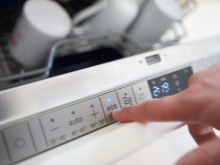
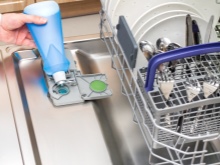

- Soak. So that no burnt or dried pieces of food remain on the dishes, they are soaked. The dishwasher design sprinkles cold water and a little detergent on the utensils and waits for a while. Soaking ensures easy removal of food debris.

- Washing. To wash the dishes, the machine sprinkles them with jets of water under pressure (the water temperature depends on the selected program). Depending on the model, the water sprays are located at the bottom, at the top, or simultaneously on both sides. The sprayers rotate and the pressure of water rinses food debris and grease from the utensils.

- Rinsing. After washing, the machine rinses the dishes several times with either clean water or water with rinse aid. If you add rinse aid to the dishwasher, there will be no traces of dried liquid drops on the utensils.

- Drying. This step is not built into all dishwashers, but most of them. There are three types of drying: hot air, condensation and mineral (zeolite drying).The first method consists in the evaporation of moisture due to the supply of hot air; for this, the mechanisms are equipped with a special heat exchanger. The second method assumes that after rinsing, the machine heats up the water (and, accordingly, the dishes) and then drains the boiling water. The walls of the machine cool down faster than the utensils, so any liquid that evaporates from the hot utensils condenses on the inside of the appliance. For the third method, a tank with zeolite is installed under the dishwasher tank - during washing, the water heats up the mineral, which in turn begins to release heat, which dries the dishes.

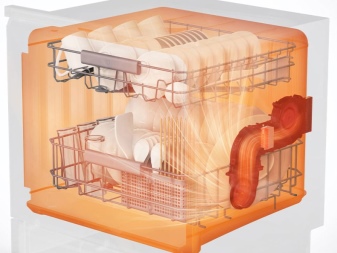
The advantage of this drying is that steam will not escape from the tank when the door is opened.
Views
Dishwashers are primarily divided into two main categories: industrial and domestic. Let's consider each group in more detail.
- Industrial. The industrial dishwasher is intended for use in hotels, cafes, restaurants and other establishments where a large amount of dishes must be washed. A professional machine is designed in such a way that it efficiently cleans a huge amount of utensils in a short period of time, and also uses resources economically. The design of products is of three types: tunnel, dome and frontal. Industrial devices are an expensive pleasure intended for large companies; it is impractical to install such equipment in apartments and private houses.
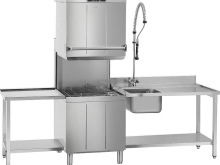
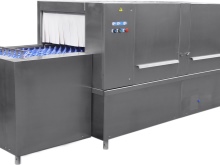
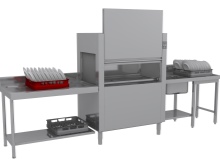
- Household. A household dishwasher must meet the needs of a wide range of people, so manufacturers create an impressive range of product models. The device for home use is distinguished not only by its wide functionality, but also by its attractive appearance.
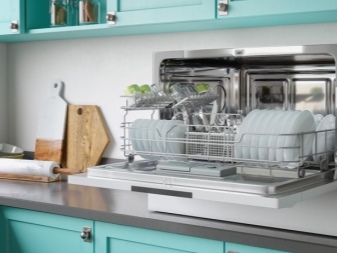
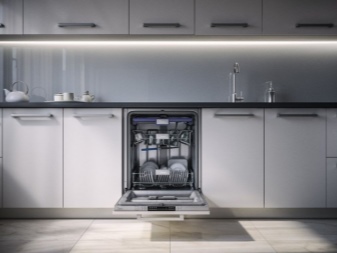
The second important classification of dishwashers occurs according to the way they are loaded, there are two types in total: horizontal and vertical loading. The way the dishes are loaded does not affect the functionality and performance of the device. Let's take a closer look at each type of download.
- Vertical loading. Top-loading dishwashers involve placing dishes in baskets and trays through the lid. Such models are limited in capacity - you can wash a maximum of 10 sets of dishes at a time.
- Horizontal loading. The design is more common than the vertical one. Sometimes such models are called frontal due to the fact that they have an external front panel that opens instead of a cover.

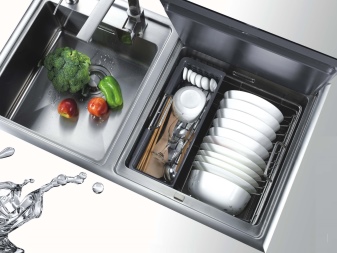
The next criterion according to which dishwashers are divided into several types is the method of installation. In total, there are four types of dishwashers according to the installation method: fully built-in, partly built-in, free-standing and compact. The principle of operation for each type of equipment is the same, the functionality does not differ either. Such a variety of forms of technology exists so that each person can choose a machine that is suitable for integration into an existing or planned kitchen interior. We suggest taking a closer look at the classification of dishwashers by installation method.
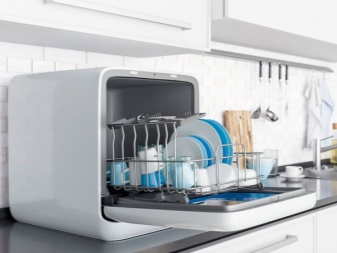
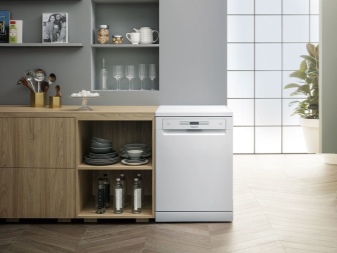
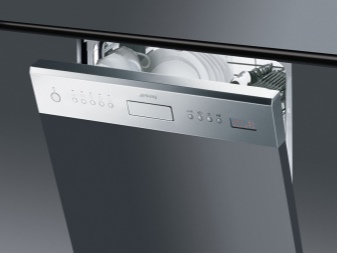
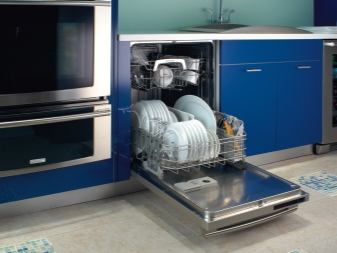
Built-in
The built-in dishwashing machine fits perfectly into almost any kitchen, because it is completely hidden with a decorative furniture panel made of the same material as all kitchen furniture. The positive side of the device is that only the owners of the apartment will know about its existence. If guests do not know that a dishwasher is installed in the kitchen, they will not even notice it, because it is built into the furniture.

The device is controlled through a special panel located on the upper end of the door. When the machine is closed, the panel is hidden under the decorative piece of furniture. This protects the technical elements of the structure from dirt and damage, but at the same time does not allow looking at the display to find out which wash cycle the machine is currently in. Several popular manufacturers such as Bosch, AEG and Siemens offer a solution to this problem. - they make models projecting the timer onto the floor covering next to the door.

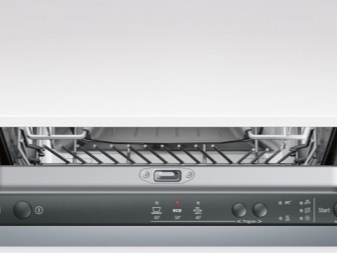
Nevertheless, such a function is not at all necessary - the product can be used comfortably without observing the display.
Freestanding
You can install a freestanding dishwasher in an existing kitchen, the main thing is to find a suitable place for it. The device is not part of the kitchen furniture, so you can install it anywhere in the room. This model is suitable for those apartments that already have a new kitchen, but still do not have a dishwasher.

Nevertheless, when buying a free-standing device, you need to think in advance about how it fits into the design of the apartment. Manufacturers create not so many color options for the case - there are only white, silver and black models. However, each color is universal, because the kitchen probably has other equipment (washing machine or gas oven), which also has a similar color.
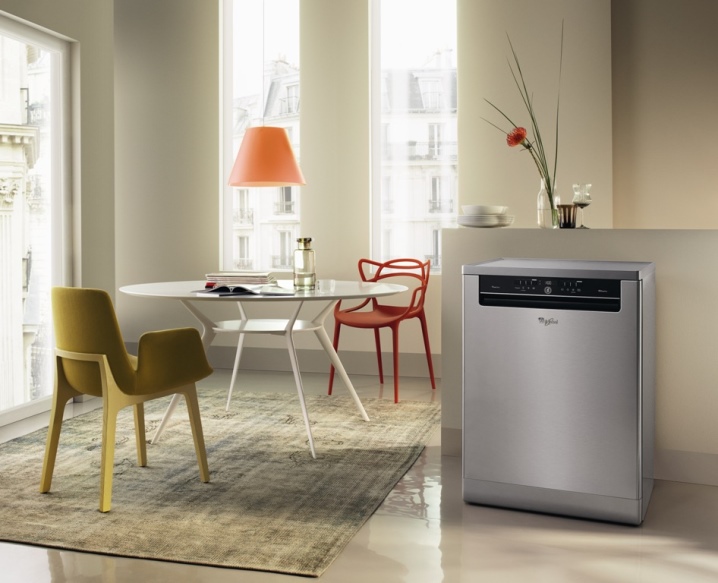
Tabletop
Dishwashers installed on the table are small in size - in most cases it is 45x55x45 cm. Such a device is usually chosen by those people who are completely unable to place other types of appliances in the kitchen. Compactness is the only positive quality of a desktop machine, which in most cases does not overcome the disadvantages.
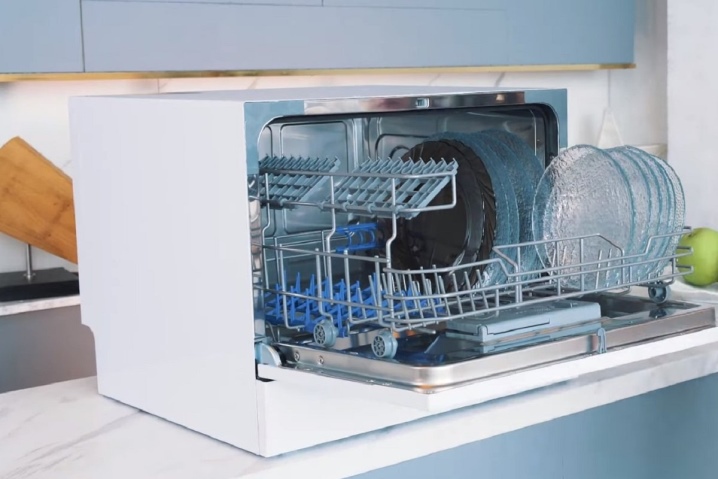
The disadvantage of the design is that it is impossible to fit more than 4 sets of dishes into it. Also, the parameters of the dishwasher do not allow pots and pans to fit into it, so some of the utensils will still have to be washed by hand. Also, many users note that the quality of work of desktop equipment leaves much to be desired, therefore, such models are purchased only in extreme cases.
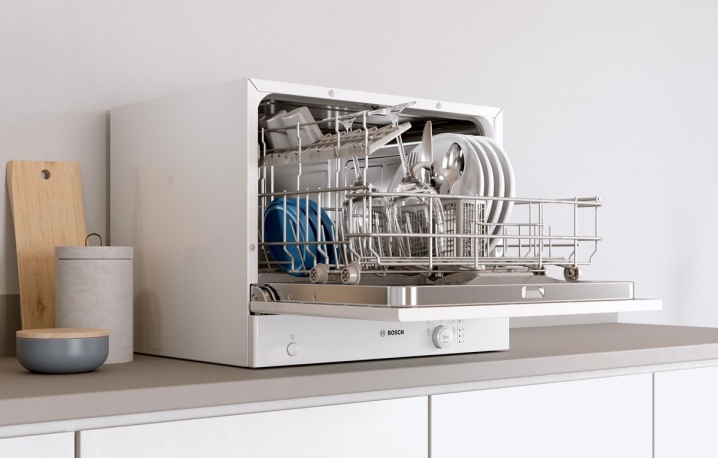
Partially recessed
The characteristics of a partially built-in dishwasher are almost identical with fully built-in models, the only difference is the installation of the control panel - it is located not in the upper end of the door, but on its front. The front panel allows you to operate the device when the door is closed, and also does not hide the display indicating the operating cycle.
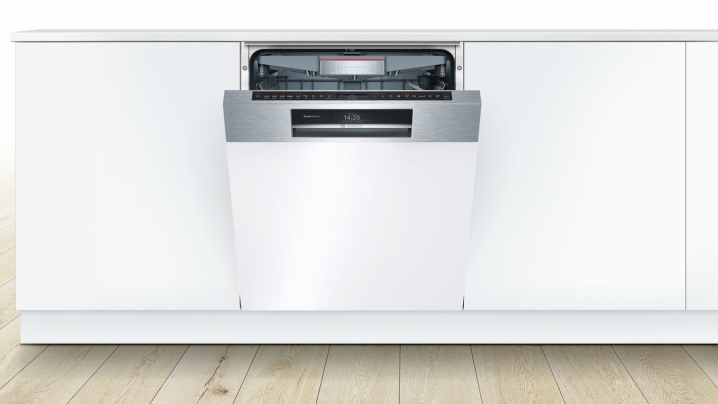
Such a dishwasher does not hide from the eyes of guests, however, it is just as convenient and functional.
Like the fully built-in models, the partially built-in machine fits into the kitchen furniture. Purchasing and installing such a device in an existing kitchen is a very difficult task. Dishwashers of this type are suitable for those owners who are just planning the interior of their apartment or are going to carry out large-scale renovations with the replacement of furniture.

Dimensions (edit)
Dishwasher dimensions are one of the most important selection criteria. Before buying, you need to consider the dimensions of the kitchen and utensils that you plan to load into the device. There are three types of dishwasher sizes in total: full size, narrow and compact. The capacity of the machines on the market today ranges from 4 to 15 sets of dishes. One set of dishes is three different plates, one glass, cup, saucer, knife, fork and three spoons. Let's take a closer look at each type.
Fullsize
The full-size model is considered standard and assumes that it will be used by a large family, as it can accommodate 12 to 14 sets of kitchen utensils. Users may wonder why so much space is needed, and the answer is quite simple - for large dishes such as pots, pans and baking sheets. Such a device has the following dimensions: width - 60 cm, depth - 60 cm and height - 80 cm. Full-size models, as a rule, have wide functionality with many additional options.
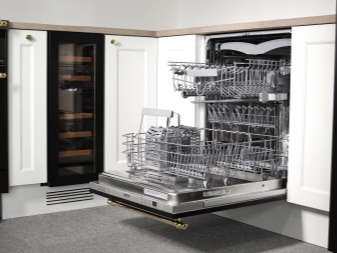
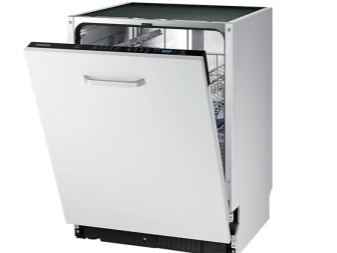
Narrow
In many apartments in Russia, not so much space is allocated for the kitchen, so the owners try to use every centimeter as efficiently as possible.The slim dishwasher is a great alternative to full-size appliances that take up too much space. The height of such products is from 70 to 85 cm, the depth is from 50 to 60 cm. Narrow dishwashers have a very small width - from 30 to 45 cm.
The capacity of devices of this type is from 8 to 10 sets, so the choice on it can be stopped for families of 3-4 people. A narrow dishwasher fits perfectly into a new kitchen if you hide it under the countertop of new furniture.
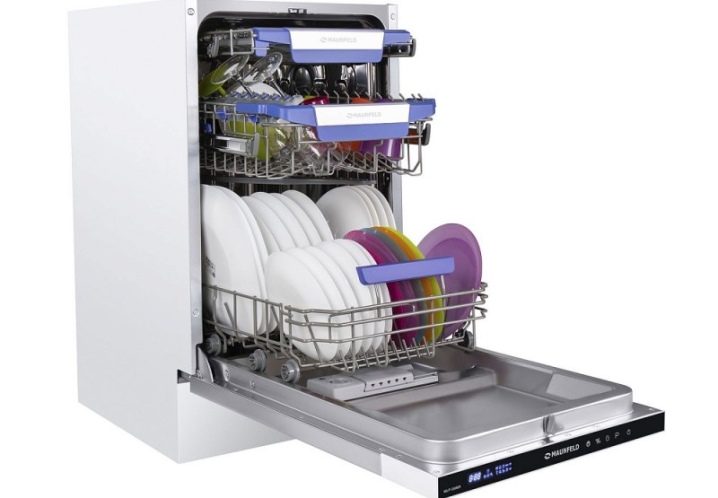
Compact
The compact dishwasher is low, shallow and lightweight, literally a miniature champion. The standard parameters of such machines are: width - 45 cm, depth - 55 cm, height - 45 cm. The low and narrow typewriter takes up very little space - it can even be placed on the kitchen counter.
The disadvantage of a compact device is its small capacity - no more than 4-5 sets of dishes. For this reason, the dishwasher is only suitable for singles and young married couples without children who do not bring guests home.
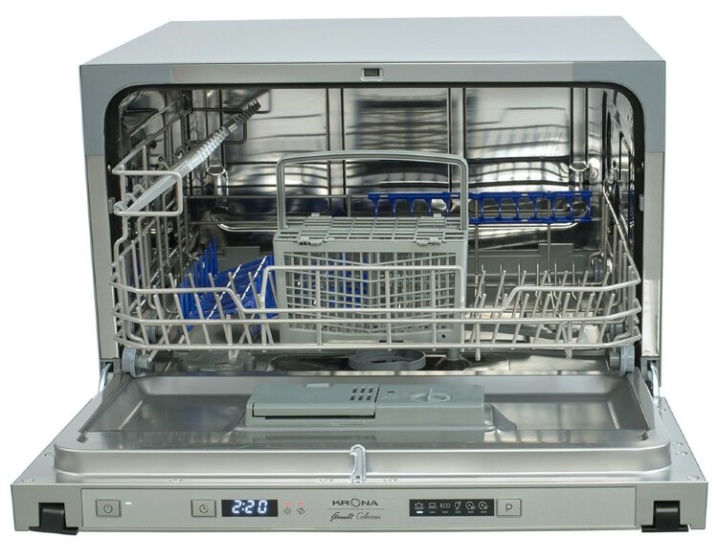
Functionality and accessories
All dishwashers are equipped with three standard dishwashing modes: normal, fast and intensive. For models from different manufacturers, these functions may differ in cycle time and the amount of resources used, so you need to compare and select those devices whose functionality suits you. Three modes are the minimum set of dishwasher capabilities that each model is equipped with. The functionality of modern devices can be improved with a large number of additional options that improve the quality of dishwashing. Let's take a closer look at several useful functions.
- Delayed start. This option allows the owners to turn on the car at any time convenient for them. For example, in order not to wash the dishes during the day, they simply load them into the basket and turn on the wash overnight so that you can use clean utensils again in the morning without unnecessary problems.
- Babycare. A very convenient function for young parents - it is designed for washing and disinfecting children's dishes, accessories and toys.
- Delicate wash. Program for cleaning fragile dishes - glasses, glasses and other utensils made of crystal or glass.
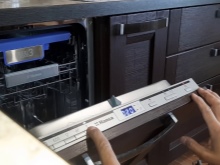
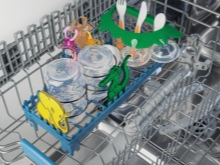

Some machines are equipped with another useful feature that does not apply to washing modes - the AutoOpen system for opening the door. Dishwashers with automatic opening dry clean dishes much more efficiently and faster.

Dishwasher accessories include baskets, trays and dish trays. Most models have two levels of grates - the lower one for plates, pots and other large dishes, the upper one for mugs, glasses and glasses. Sometimes there are models with a third level, designed for cutlery, but this is a real rarity - more often the place for spoons, forks and knives is placed in the middle of the first or second level.
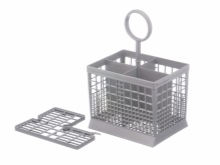
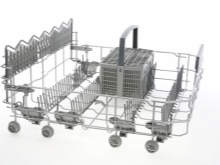
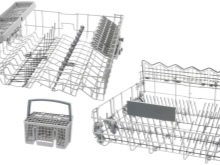
Top Models
Not only the functionality and dimensions of the dishwasher play an important role in choosing the right model - firms also play a significant role. The quality of work and durability of the equipment very often depends on the brand of the device, therefore it is necessary to pay attention to the manufacturer of the “home assistant” you like. We suggest considering some of the best models of dishwashers from popular companies.
- Bosch Silence SMS24AW01R. High-quality full-size German appliances with good storage capacity (up to 12 sets of dishes). Night operation of the device will not cause discomfort for the residents of the house, because the model belongs to a series of quiet cars.
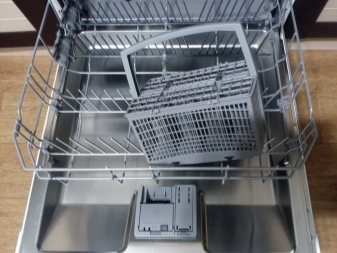
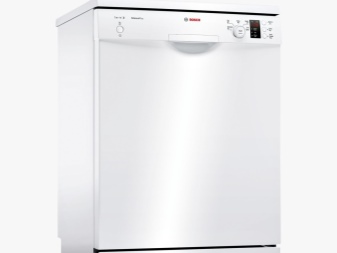
- Gorenje GS54110W. A narrow and spacious dishwasher from Slovenia - it can wash up to 10 sets of dishes at a time. Manufacturers have provided an intensive washing zone in the machine for dishes with burnt or dried food.
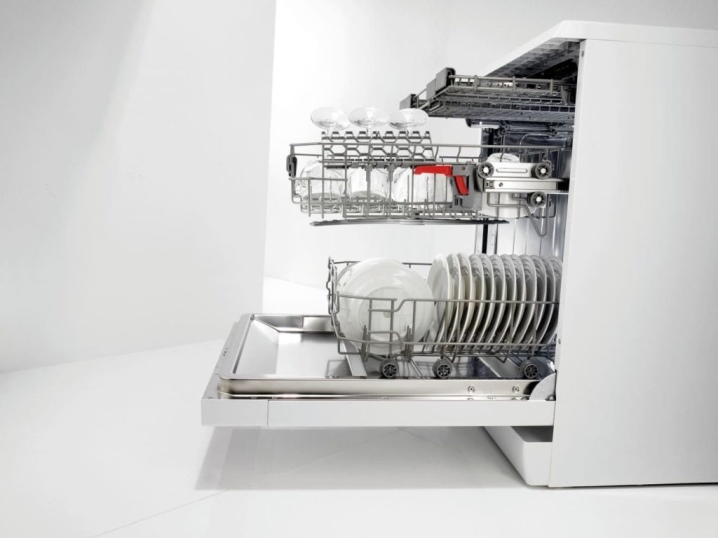
- Miele G 5481 SCVi. A Czech company that has collected numerous positive reviews from the owners of kitchen appliances of this brand.The Miele G 5481 SCVi dishwasher is a comfortable, slim model that is fully integrated into kitchen furniture. The functionality of the device includes a special program for gentle cleaning of crystal and glassware. The maximum capacity of the Miele G 5481 SCVi is 9 place settings.
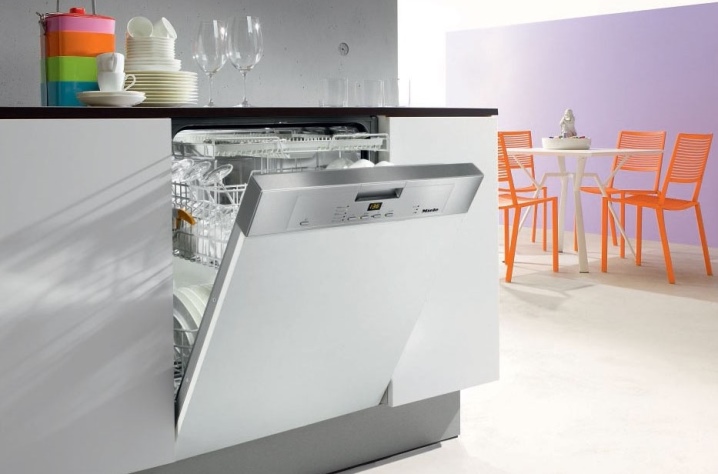
- Bosch ActiveWater Smart SKS41E11RU. One of the few high-quality compact dishwashers designed for use in the country or in a small family. The capacity of the device is 6 sets of kitchen utensils. The machine is equipped with a quiet motor, 4 washing modes and a sensor that helps to arrange the dishes in the baskets correctly.
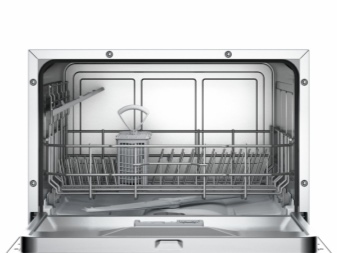
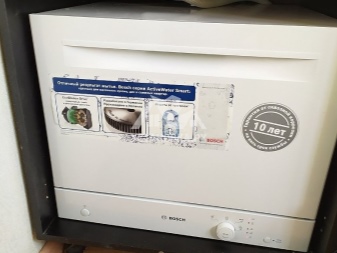
How to choose the right one?
The most important factor that determines the choice of a dishwasher is its purpose. For catering, canteens, cafes and other public institutions, it is necessary to purchase industrial equipment that can quickly cope with a large amount of dishes. When buying a device for a home, you need to select a model according to the number of people living:
- roominess in 4-5 sets is enough for 1-2 people;
- a car with a capacity of 6 to 10 sets is suitable for families of 3-5 people;
- dishwasher with a capacity of 10-14 sets is intended for families of 5-6 people.
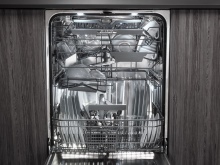
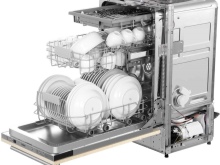
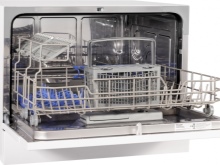
Selection by parameters is also important, because not every kitchen is capable of accommodating a full-size car. In most cases, the built-in narrow model, which is included in the new kitchen set, becomes the best option.
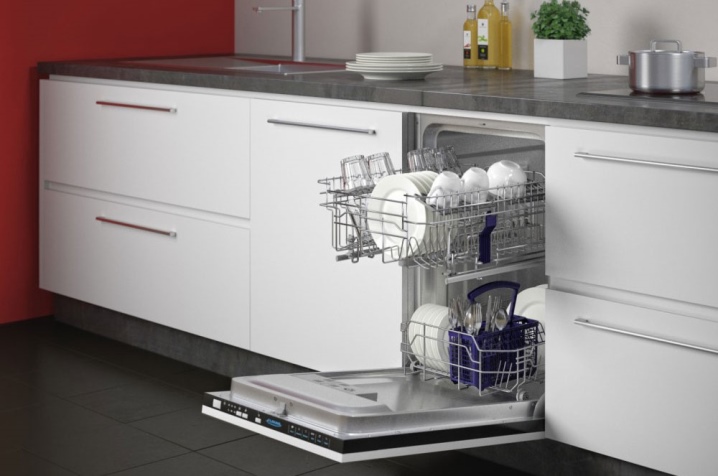
If you decide to buy a free-standing model, be sure to check it for all criteria so that it fits into the kitchen and meets the needs of residents.
In order to individually select a high-quality model, it is necessary to pay attention to additional software and mechanical functions. Expert advice will help you make the right choice:
- the quality of the model greatly affects the service life, so you should not save money, preferring the product of an unknown brand;
- if you have small children in your house, you need to pay attention to dishwashers with "child lock" protection;
- machines with the "half load" program perfectly save resources, because for washing it is not necessary to wait until the trays are full - this helps a lot in those moments when the baskets of utensils are not full in a day;
- additional features greatly affect the cost of a dishwasher, so think carefully about which features you need and which you don't;
- the lack of spaciousness will force the owners to wash large dishes by hand, so it is better to give preference to models designed for 7-10 sets of dishes.

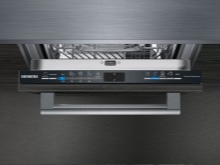
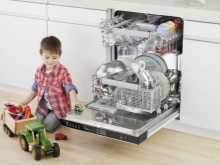













The comment was sent successfully.